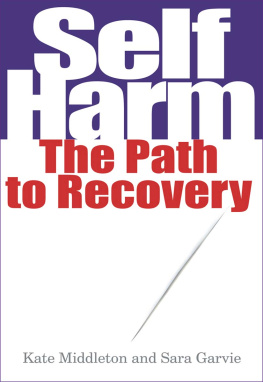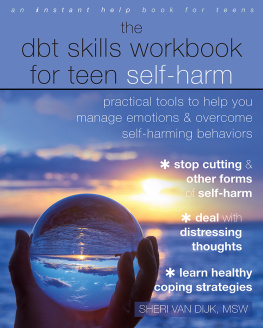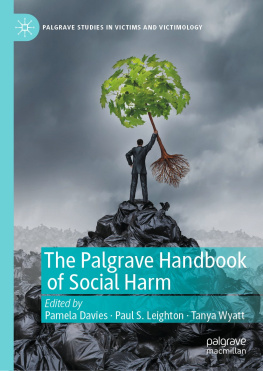Understanding and Responding to Self-Harm:
The One-Stop Guide
Understanding and Responding to Self-Harm:
The One-Stop Guide
Practical advice for anybody affected by self-harm
Allan House

First published in Great Britain in 2019 by
PROFILE BOOKS LTD
3 Holford Yard
Bevin Way
London
WC1X 9HD
www.profilebooks.com
Copyright Allan House 2019
The moral right of the author has been asserted.
All rights reserved. Without limiting the rights under copyright reserved above, no part of this publication may be reproduced, stored or introduced into a retrieval system, or transmitted, in any form or by any means (electronic, mechanical, photocopying, recording or otherwise), without the prior written permission of both the copyright owner and the publisher of this book.
The advice and recommendations given in this book are provided in good faith, but no responsibility for any consequences, however caused, of acting on them will be accepted by the author or the publisher. If in doubt, seek suitable advice from a healthcare professional.
A CIP catalogue record for this book is available from the British Library.
ISBN 9781788160278
eISBN: 9781782834359
Introduction
Its not difficult to find things to read about self-harm in magazines, books or on social media its a topic that seems to attract attention from all sections of society. Thats no surprise really. With more than one in five young people reporting that they have self-harmed at some time, it is something that will have touched the lives of most of us whether weve done it ourselves or are the friends or families of those who have.
The trouble is that what you can read about self-harm is not always helpful. Film stars who talk about it can make it sound like a lifestyle choice. Melodramatic accounts of self-harm in the lives of mass murderers make it sound like a symptom of deep disturbance. Gloom-laden stories about suicide in young people touch on an important topic, but sometimes they seem designed to cause shock and dismay rather than to help our understanding of the problem and what we can do about it.
What is harder to find is a simple account of what self-harm is, what we know about its causes, and what you can do to seek or offer help. It is this gap that this book aims to fill, by offering clear and sound advice.
The book covers some important topics including what self-harm is and the reasons for it. It seeks to explain the apparent contradiction that self-harm isnt the same as attempted suicide and yet the person doing it may be suicidal. Self-harm isnt something that only young people do, or only women, and it certainly isnt something that people just do for attention. I will look at the role of social media and whether its true that it makes self-harm in young people more likely. You may have read about self-harm and people with so-called personality disorder an idea that has broken through into popular journalism What to do if your partner has borderline personality disorder and so on. Ill explain what this term means, and discuss what psychiatry has to offer in more useful ways than attaching labels to people. And most importantly this book will challenge the idea that you cant do anything about self-harm it is possible to help.
In writing this book I have drawn heavily on my own experience over many years of talking to people who have self-harmed and to others who have approached me for advice about somebody they are concerned about. For fifteen years, I worked as a consultant in a busy hospital-based self-harm service in which we saw many hundreds of people each year, and both the users of our service and the staff I worked with taught me much.
Throughout this book you will find quotes from people who have self-harmed, descriptions of people and their problems, and brief boxed case studies. All these accounts are based upon real people, but I have made sure of confidentiality by changing names and some of the personal details so that nobody can be identified.
As well as being a psychiatrist, I am also an academic and researcher, and so what I have to say in this book is based not just on my personal and professional experience but also upon research, some of it mine, much of it by others.
I wrote this book with a wide audience in mind people who have harmed themselves and those who live with them, care about them or support them, and people who work in roles that bring them into contact with self-harm: in fact, anybody with a genuine interest, perhaps a little knowledge, and a desire to understand the topic more deeply. It saddens me to hear how often someone who self-harms has sought help and yet not found it easy to get. Those close to them have responded with shock, dismay, anger or panic and havent known what to do. Professionals have been apparently uninterested or unable to offer anything. And yet my experience is that many people do want to help they just dont understand the problem and dont know what to do about it. This book is also for them.
This book can be read cover to cover, but I know that many people dont read like that, so each chapter can be read on its own. That occasionally requires a little repetition, which I have tried to keep to the minimum required to make each chapter stand alone.
You may find some of what I have to say about what people do and why they do it quite direct I think it is important to be clear in describing and discussing the issues. I hope you do not find any of the detail too upsetting, and above all I hope you find what I have to say informative and, more importantly, helpful.
part one
What is self-harm?
chapter 1
What do we mean by self-harm?
If you are trying to find out about self-harm (especially by looking online) you can end up muddled by what seem to be contradictory statements. Or you may read something about self-harm and think thats all very well but it doesnt apply to me even though you yourself self-harm or know somebody who does. Of course, self-harm is an emotive topic and that is partly why the way in which people talk about it gets muddled. Another reason is that the expression self-harm isnt used at all consistently. So, to avoid confusion, lets start by examining what self-harm is, and exploring how different terms are used by different people. On the way, we will also debunk some of the myths that surround the topic.
Defining self-harm: keep it broad and keep it simple
WHO, the World Health Organization, issues definitions of illnesses and conditions. The WHO defines self-harm as
an act with non-fatal outcome, in which an individual deliberately initiates a non-habitual behaviour that, without intervention from others, will cause self-harm, or deliberately ingests a substance in excess of the prescribed or generally recognised therapeutic dosage, and which is aimed at realising changes which the subject desired via the actual or expected physical consequences.
That definition means that self-harm is intentional, is done by somebody to themselves, and is done by someone who wants to make something change. By saying it is non-habitual it means that it is done as a conscious act, separate from normal day-to-day life.
The WHO definition might seem a bit mind-boggling and rather legalistic-sounding, so heres a simpler one, adopted by the UKs National Institute for Health and Clinical Excellence (usually called NICE): self-poisoning or self-injury, irrespective of the apparent purpose of the act.
Next page













